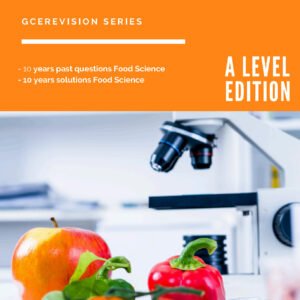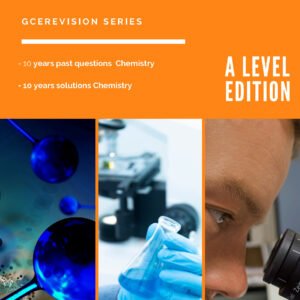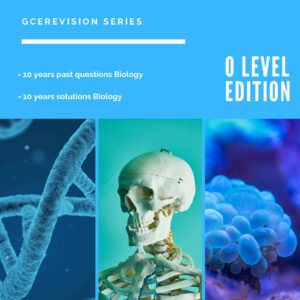CHAPTER FOUR
4.0 PHYLUM PLATYHELMINTHES (FLAT WORMS)
4.1 General Characteristics of members
- They have a flat shape (“Platy = flat; helminth = worm)
- They are unsegmented (like nematodes)
- They are bilaterally symmetrical
- All have a mouth but most have no anus
- They are acoelomates
- They have no coelom
The coelom is a fluid filled cavity found in the mesoderm of triploblastic organism in which organs like muscles, bones, heart etc. are suspended
- They are triploblastic i.e. their body wall consists of 3 layer of cell ectoderm, mesoderm and endoderm.
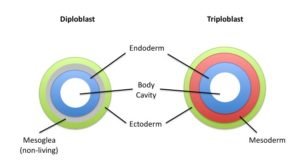
Fig: transverse section of a flatworm to show 3 cell layer
4.2. Body Plan of Platyhelminthes
The endoderm is found on the outside, the endoderm on the inside, while the mesoderm is found between them. The mesoderm forms the bulk of the body because it gives rise to many structures like muscles, heart etc. Platyhelminthes have an organ level of organization (unlike the Cnidarians which have tissue level of organization) Each of their organs is specialize to carry out a particular function in the body. The have an enteron(gut) but lack a coelom like in the cnidarians simple diffusion is enough for substances to be transported through their bodies because they are relatively simple.

Fig: transverse section of a flatworm showing it organ level of organism
Platyhelminthes have 2 possible modes of life some are free living while others are parasitic
4.3 Free Living Platyhelminthes
They are predominantly aquatic and belong to the class called turbellaria. Their outer body surface is ciliated. They use the cilia to beat through water thereby creating turbulence (the word from which their class name is derived) This helps them to move a common example of tubullarence is Planaria a fresh water Flatworm
4.3.1 Nutrition in Planaria
Planaria is carnivorous feeding in on small worms, crustacean and the dead body of larger organism. Its posses’ glands on it ventral surface which secrete mucus which helps it to immobilize the food. Planaria has a pharynx (esophagus) which can be protruded through the mouth. By so doing it pours enzymes upon the food which get it partially digested. Next, it sucks up the food into the mouth and digestion is completed between a well develop digestive system planaria has no anus and so undigested food is expelled through the mouth.
4.3.2 Coordination in Planaria.
Planaria has a well develop central nevour system (C.N.S) it has a brain in it head made up of dense cluster of nerve cells. A pair of nerve chords connect the brain with small nerves throughout the body. It sense organ include: A pair of simple eyes on the head and chemoreceptors on its lateral lobes. The chemoreceptors help it to locate food
Fig: external features of planaria
4.3.3 Reproduction of Planaria
Like most flatworms planaria is a hermaphrodite nevertheless, cross fertilization usually occurs. Also, planaria can also produce asexually by splitting into two then each fraction then regenerates the missing part.
4.4 Parasitic Platyhelminthes
Parasitism is a relationship between two organisms from which one of then called the parasite benefits while the other called the host suffers harm. Many platyhelminths are parasite most of them living within their host (endoparasite). Their host are animals from different species. Parasitic flatworms come from 2 classes; TREMATODA & CESTODA
4.4.1 Parasitic Trematodes.
The most common trematode is the liver fluke fasciola hepatica

Fig: diagram of liver fluke
4.4.2 Life cycle of fasciola Hepatica (Liver Fluke)
The adult lives in the bile duct of its primary host. This could be sheep, goat, cattle and occasionally humans. The adult lays egg which passes out in the host feces. Next the egg hatches into miracidia which are ciliated and so can swim. They penetrate the skin of an aquatic snail which is a secondary host. In the snail they develop into other larvae forms; Radiae and cercariae. The cercariae lives the snail body and found on vegetation. They become encysted (cyst) to avoid being destroyed by harsh conditions when the primary host comes feeding, it picks up the cercarium. This grow into adults and they establish in the Bile duct and the life cycle is taken over again which is repeated after metabolism.
Fig: diagram of life cycle of Fasciola hepatica
4.4.3 Parasitic Cestodes
The commonest examples are Taenia Saginata (beef tapeworm) & Taenia solium(pork tapeworm)
Both have 2 host the primary being humans and the secondary being cattle & pigs respectively

Fig: structure of adult tapeworm
4.4.4 Life Cycle of Tapeworms
The adult lives in the ileum of their primary host using their hooks and or suckers. They burry their heads in the intestinal wall of the primary host while the rest of the body is bathed in nutrients. By simple of the body is bathed in nutrients. By simple diffusion, the nutrients from the host ilium enter the worm. Hence tapeworms do not need any digestive system of their own.
Mature proglottids filled of fertilized eggs cut off from the tail end of the organism and are passed out with the host feces while on vegetation, the egg, called onchospheres can be eaten by the appropriate secondary host. In its intestine, the egg shell is digested producing a hexacanth (six-hooked larva) this larva penetrates the intestinal wall and enters blood vessels from where it is carried to the muscles of the secondary host either raw or poorly cooked, the bladder worm enters the intestine and grow to adult. This cut off mature proglottids and the life cycle grows about again.
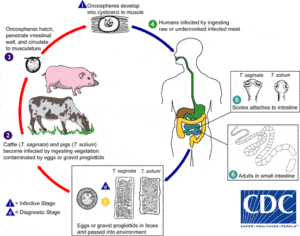
Fig: schematic diagram of the life cycle of tapeworm
4.5 Adaptation of parasitic worms to their mode of life
- Locomotion: Structure are generally reduced or absent. They have special ways of gaining access into their host.
- They posses’ hooks & suckers with which they anchored their bodies into their host to avoid flushed out.
- Parasitic degeneration has occurred in them i.e. they have lost the structure no longer needed e.g. eyes, limbs, and antennae
- They produce chemicals which protect them from the host immune responses
- They have a very high reproductive output i.e. they lay many eggs
- They are hermaphrodite
- They have two hosts
- They have flat bodies for easy food absorption
4.6. Classification of Platyhelminthes
| characteristics | Class Turbellaria | class Trematoda | Class cestoda |
| Mode of life | Free living | Larvae free living adult parasitic | Parasitic |
| Body structure | Delicate and soft | Leaf like | elongated with many proglottids |
| Suckers and hooks | Suckers are rare & no hooks | 2 suckers: 1 ventral, no hooks | Suckers and hook present on the head |
| Cuticle | Absent | Present; thick | Present; thick |
| Enteron | Present | Present | Absent |
| Cilia | Present | Present in larvae, absent in adult | Absent |
| Sense organs | Present e.g. eyes and lateral lobes | Present in larvae, absent in adult | Present in free living larvae, absent in adults |
| Examples | Planaria | Casciola: Liver flukes
Schistosoma: blood fluke |
Taenia |

